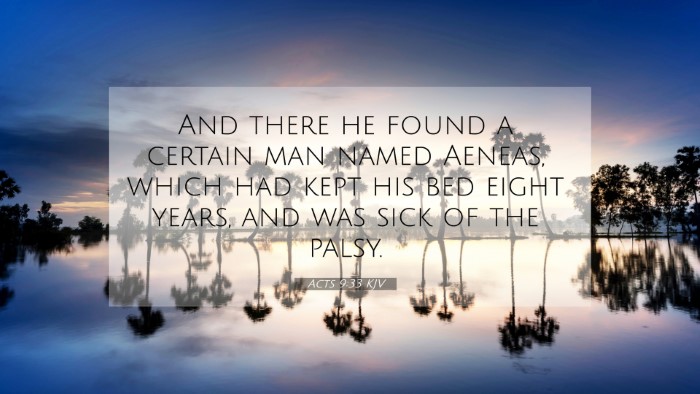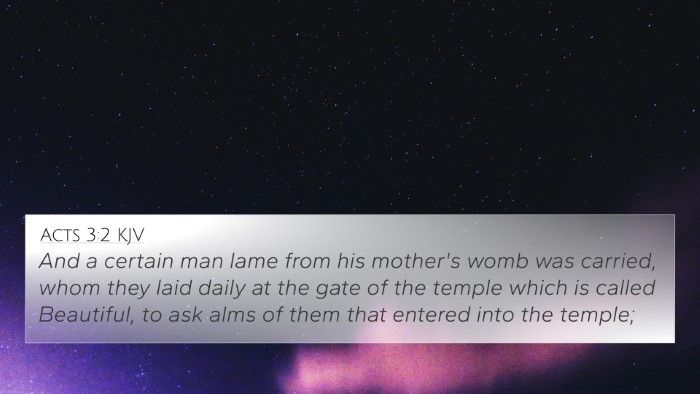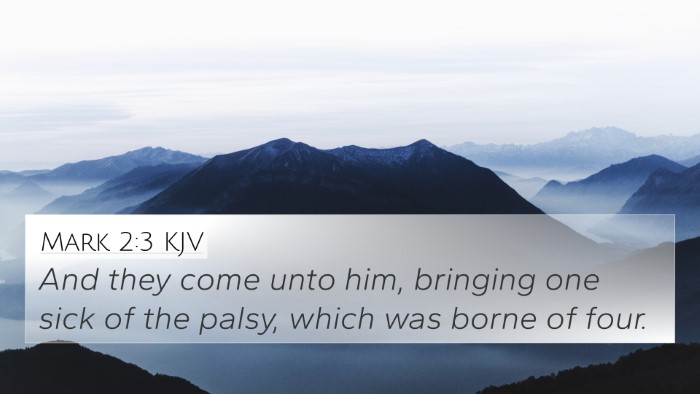Understanding Acts 9:33
In the Book of Acts, Chapter 9, verse 33, we encounter a significant moment that reflects the ongoing ministry and miraculous works performed through the apostles after Jesus' ascension. This verse is critical not only for its immediate context but also for its broader implications within the New Testament narrative.
Verse Context
Acts 9:33 states:
"And there he found a certain man named Aeneas, which had kept his bed eight years, and was sick of the palsy."
Commentary Insights
This verse highlights Peter's ministry as he travels and performs miracles, illustrating the power of God working through him. Below are interpretations derived from renowned public domain commentaries:
- Matthew Henry: Henry emphasizes the compassionate nature of Peter's ministry. He notes that finding Aeneas represents the divine providence of God in leading Peter to those in need of healing and redemption.
- Albert Barnes: Barnes discusses the nature of Aeneas' illness and the duration of his suffering. He points out that the healing signifies both a physical and spiritual restoration, serving as a manifestation of God's power.
- Adam Clarke: Clarke stresses the importance of the healing, suggesting that it serves as a sign to establish the authority of the apostles. He also mentions that Aeneas' condition is a typology of sin, showcasing a deeper spiritual implication of being 'bedridden' under the burden of sin.
Key Themes and Connections
Acts 9:33 serves as a nexus for multiple Bible verse connections. It illustrates themes central to both the individual and corporate experience of healing and restoration in the faith community.
Thematic Bible Verse Connections
- James 5:14-15: "Is any among you sick? let him call for the elders of the church; and let them pray over him, anointing him with oil in the name of the Lord." This verse emphasizes the community's role in healing.
- Matthew 9:12: "But when Jesus heard that, he said unto them, They that be whole need not a physician, but they that are sick." This shows the divine attention on those who are spiritually or physically in turmoil.
- John 14:12: "Verily, verily, I say unto you, He that believeth on me, the works that I do shall he do also; and greater works than these shall he do; because I go unto my Father." This relates to the works done by the apostles.
- Luke 7:21: "And in that same hour he cured many of their infirmities and plagues, and of evil spirits; and unto many that were blind he gave sight." It signifies Jesus' healing ministry, which the apostles continue.
- Acts 3:6: "Then Peter said, Silver and gold have I none; but such as I have give I thee: In the name of Jesus Christ of Nazareth rise up and walk." This creates a parallel to Peter’s command to Aeneas.
- 1 Peter 2:24: "Who his own self bare our sins in his own body on the tree, that we, being dead to sins, should live unto righteousness: by whose stripes ye were healed." This verse gives theological context to healing through Christ.
- Mark 16:17-18: "And these signs shall follow them that believe; In my name shall they cast out devils; they shall speak with new tongues; They shall take up serpents; and if they drink any deadly thing, it shall not hurt them; they shall lay hands on the sick, and they shall recover." This demonstrates the authoritative power given to believers.
Conclusion
Acts 9:33 emphasizes a vital connection between the ministry of Peter and the broader narrative of healing in the Acts of the Apostles. By analyzing this verse alongside others, readers can gain a comprehensive understanding of the biblical themes of healing, faith, and the role of the church in the early Christian community. This passage offers an invitation to explore deeper connections and cross-references throughout scripture.
Using Bible Cross-References
For those seeking to engage in comparative Bible verse analysis, a robust Bible cross-reference guide can enhance understanding and facilitate deeper studies. Tools for Bible cross-referencing can lead to rich insights into how various scriptures reinforce and illuminate each other, forming a cohesive theological framework.
Helpful Tools
- Bible concordance – Helps locate specific words and phrases across the scripture.
- Bible reference resources – Guides for exploring scripture details.
- Cross-referencing Bible study methods – Techniques to identify and study connections between verses.
- Comprehensive Bible cross-reference materials – Books and resources for deep exploration.












